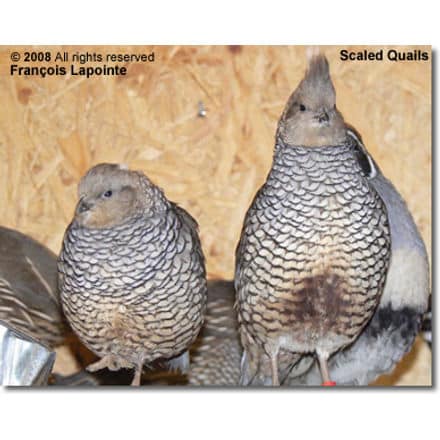Chicken or Fowl Pox
The Chicken Pox or Fowl Pox (Sorehead) is caused by a virus of the family Poxviridae and the genus Avipoxvirus.
This is a woldwide disease that can be transmitted by direct or indirect contact, as well as through biting insects.
It commonly affects poultry, such as chickens and turkeys; but also quail, canaries, pigeons, and many other species of birds have come down with this disease.
The disease manifests itself in one or two ways, cutaneous pox (dry form) or diphtheritic pox (wet form).
- Dry Form: Spread by biting insects (especially mosquitoes) and wound contamination. Dry pox starts as small whitish infection that develops into wart-like nodules. The nodules eventually are sloughed and scab formation precedes final healing. Lesions are most commonly seen on the featherless parts of the body (comb, wattles, ear lobes, eyes, and sometimes the feet and around the vent). Mosquitoes can harbor ineffective virus for a month or more after feeding on affected birds.
- After the infection is introduced, it spreads within the flock by mosquitoes as well as direct and indirect contact. (If mosquitoes are problem in your area, here are some tips to control these pests.) Birds affected by this form usually recover within a few weeks. The good news is that recovered birds do not remain carriers.
- Wet Form: The second form is spread by inhalation of the virus and causes a diphtheritic (false) membrane to form in the mouth, pharynx, larynx, and sometimes the trachea. Yellowish cheese-like areas may occur on the inside of the mouth.
- The prognosis for this form is poor.
Index of Bird Diseases … Symptoms and Potential Causes … Bird Species and Diseases They are Most Susceptible to

Disease Progression
Fowl pox tends to spreads slowly and a flock may be affected for several months. The course of the disease in the individual bird takes three to five weeks.
- Affected young birds are retarded in growth.
- Laying birds experience a drop in egg production.
- Birds of all ages that have oral or respiratory system involvement have difficulty eating and breathing.
Fowl pox is usually easily diagnosed based on flock history and the presence of typical lesions. In some cases, laboratory diagnosis by tissue or transmission studies may be necessary.
Treatment, Control and Prevention
There is no treatment for this condition. In many cases, the disease may resolve itself. It is important to control any mosquito infestations and sanitize the premises the fowl is in to minimize exposure. The virus is highly resistant in dried scabs and under certain conditions may survive for months on contaminated premises.
NOTE: Infected birds are susceptible to secondary infections that often lead to death. Therefore, sanitation is of utmost importance.
In order to stop / slow down the spread of this disease, sick birds should be separated from those that appear to be healthy and provided supportive care to maximize its chances of a quick recovery.
Disease control is accomplished best by preventative vaccination since ordinary management and sanitation practices will not prevent it. Birds intended for laying purposes should be vaccinated. Birds whose resistance has been weakened through any condition or disease should not be vaccinated until they are healthy.
Vaccination of broilers is not usually required unless the mosquito population is high or infections have occurred previously. The chicks may be vaccinated as young as one day of age by using the wing-web method and using a one needle applicator. All replacement chickens are vaccinated against fowl pox when the birds are six to ten weeks of age. One application of fowl pox vaccine results in permanent immunity. (Source: Mississippi State University).
NEED A VET?
USA: Find Your Local Avian Veterinarian
Information contained on this website is provided as general reference only. For application to specific circumstances, professional advice should be sought.



